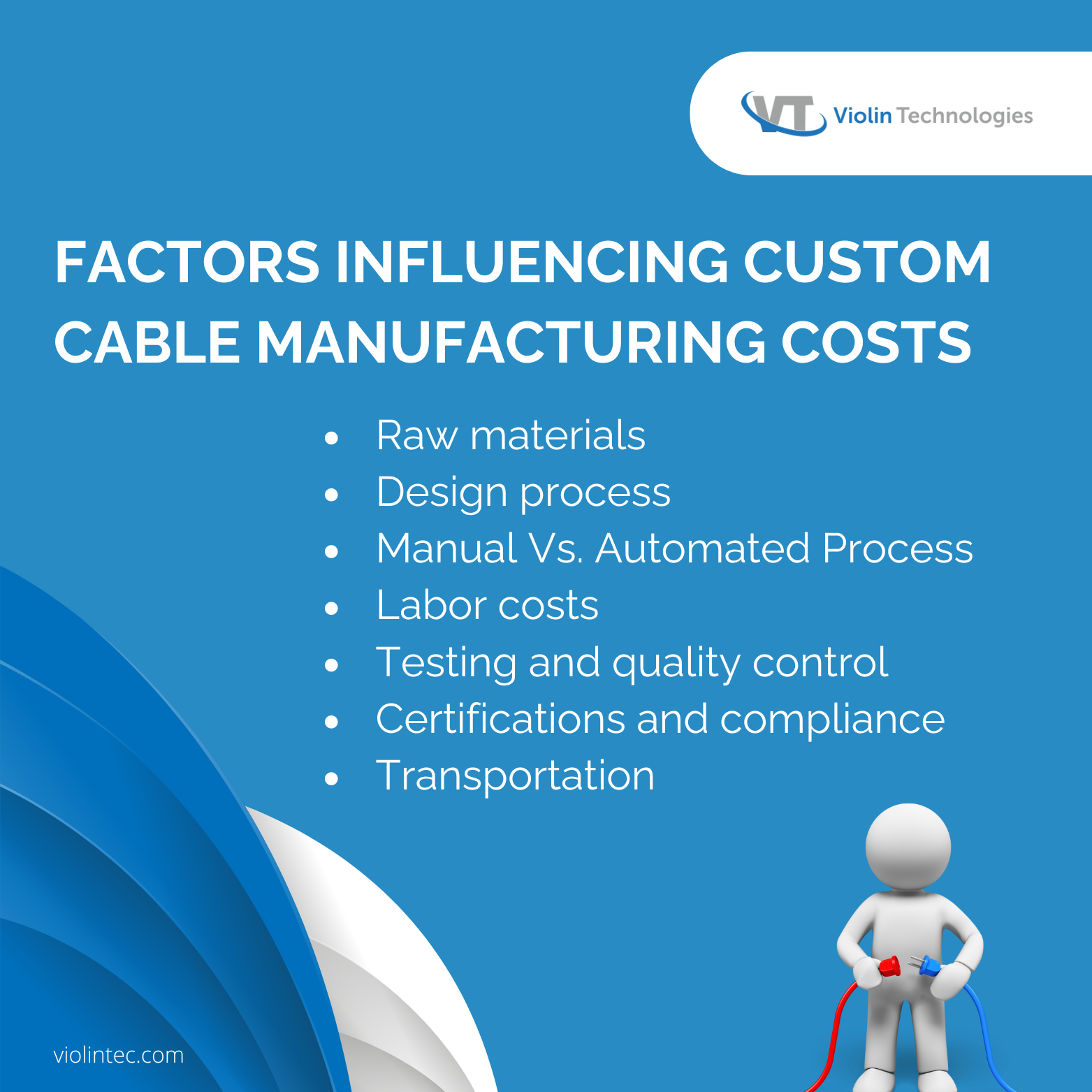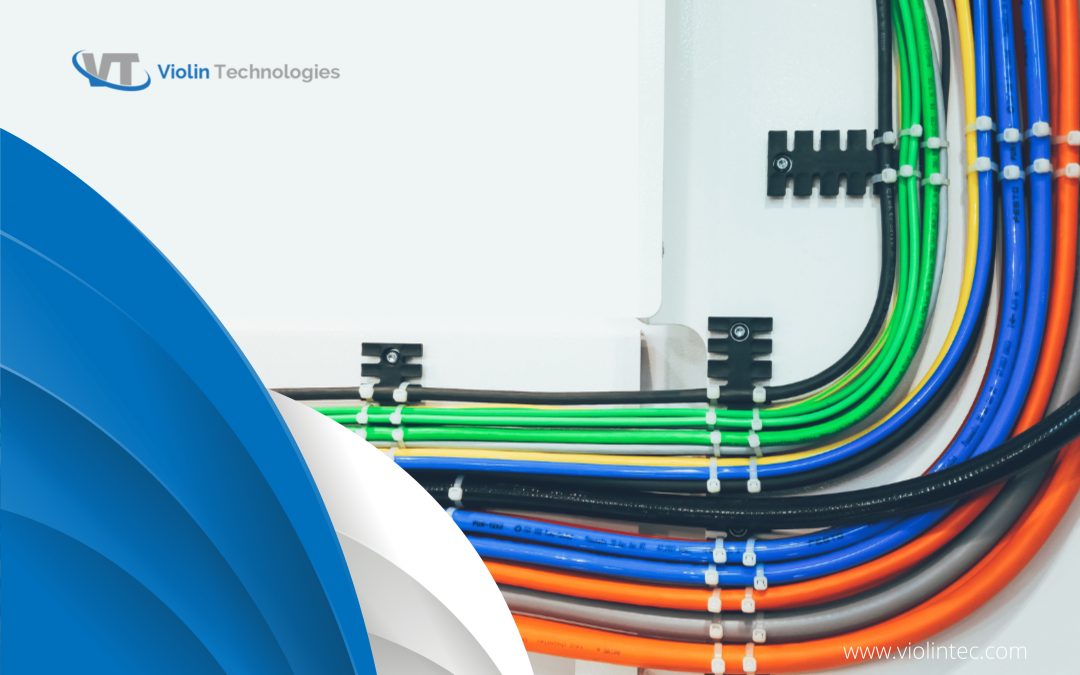By delving into the intricacies of substance selection, design intricacies, production methodologies, and testing protocols, stakeholders can strategically enhance efficiency and minimize expenditure. This holistic approach not only ensures that custom cable assemblies meet stringent industry requirements but also fosters innovation in delivering robust solutions tailored to specific operational needs.
What we cover in this blog?
Key Takeaways
- Early collaboration with suppliers optimizes cost and performance in custom cable assembly.
- Designing for manufacturability reduces labor and rework expenses.
- Standardizing components cuts costs and shortens lead times.
- Value engineering ensures cost efficiency without compromising quality in cable assembly production.
Factors Influencing Custom Cable Manufacturing Costs
1. Raw Materials
The cost and type of raw materials play a crucial role in determining the overall price of a custom cable assembly. Here’s a breakdown of the key material components:
Conductors: Copper is the common choice, though aluminum can be a more affordable alternative. The conductor’s size, purity, and stranding configuration (solid vs. stranded) all affect the cost.
Insulation and Jacketing: Materials range from basic PVC to high-performance options such as Teflon or silicone. The material’s properties—temperature resistance, flexibility, and chemical resistance—influence the price.
Shielding: Shielding protects signals from electromagnetic interference (EMI). Options include foil, braiding, or a combination, each with different cost implications.
Connectors: A wide variety of connectors exist, from basic terminals to complex multi-pin connectors. Material selection (plastic vs. metal), plating (gold, tin), and the number of contacts directly impact costs.
2. Design Process and Innovation
A cable assembly’s design complexity greatly influences its manufacturing cost. Here are the key factors:
Length: Longer cables use more material, which raises costs. To reduce expenses, opt for the shortest feasible length for your application.
Harnessing and Routing: Intricate cable harnesses with multiple branches, breakouts, or complex routing paths require additional labor and specialized tools, increasing costs.
Tolerances: Tight tolerances demand more precise manufacturing processes and stringent quality control, affecting production costs.
Environmental Requirements: Assemblies designed for harsh conditions (extreme temperatures, chemicals, vibration) often require specialized materials and construction techniques, which results in higher costs.
Custom Cable Manufacturers specialize in creating tailored solutions to challenges that meet specific execution criteria and reliability standards across diverse industries. They leverage innovative designs, advanced materials, and rigorous evaluation to ensure their custom cable assemblies deliver optimal outcomes and durability.
3. Manual Vs. Automated Production Processes
The choice between manual processes and automated tools significantly affects production costs. Physical operations offer flexibility for low-volume or intricate designs but are labor-intensive, leading to higher costs. In contrast, automated production lines excel in high-volume manufacturing, offering substantial cost savings per unit.
Wage costs vary based on geographical location, with regions offering lower wage costs providing a competitive advantage. However, considerations such as worker expertise and quality control processes are critical. Advanced manufacturing tools may involve higher initial investments but can reduce manufacturing times and associated wage costs over time.
4. Labor Costs
Skilled labor is crucial for custom cable assembly manufacturing. Factors influencing labor costs include:
Location: Labor rates vary by country and region, impacting production costs.
Complexity: Complex assemblies require more time and expertise for tasks such as cutting, stripping, termination, testing, and assembly operations.
Production Volume: Lower volumes often rely on more manual processes, whereas high-volume production can leverage automation to reduce costs.
Custom cable manufacturers in India cater to a wide range of industries, offering bespoke solutions tailored to meet stringent efficacy and cost-efficiency requirements. Leveraging local expertise and advanced manufacturing capabilities, these manufacturers ensure high-quality custom cable assemblies and innovative solutions that meet global standards.
5. Testing and Quality Control
Thorough testing is essential to ensure custom cable assemblies meet performance specifications and are defect-free.
Testing may involve:
- Continuity Testing: Ensures electrical connections within the cable are intact.
- Hi-pot Testing: Checks insulation integrity under high voltage.
- Environmental Testing: Evaluates performance in harsh conditions (temperature, humidity, vibration).
- Signal Integrity Testing: Measures characteristics like impedance and attenuation for high-speed data cables.
Stringent testing demands and higher quality standards increase manufacturing costs.
6. Certifications And Compliance
Does your product require certification from third-party organizations? These third-party compliance processes are time-consuming and costly. Therefore, it’s crucial to include these expenses in your product’s manufacturing budget from the outset. Ignoring this important factor until late in the process can unexpectedly inflate manufacturing costs and significantly delay product development.
7. Transportation
Logistics and transportation are inherently complex and costly aspects of manufacturing. Overseas supply chains, in particular, incur significant expenses, whereas nearshoring presents a more economical alternative.
Nearshoring involves:
- Sourcing raw materials and essential items from nearby facilities.
- Enhancing project management efficiency.
- Reducing production costs.
- Optimizing daily supply chain operations.
Additionally, the shorter distance in transportation ensures faster delivery and lower transit costs, contributing to overall manufacturing cost savings.

Reducing Costs Through Long-Term Strategies
Now that you grasp the factors influencing costs let’s explore strategies to manage expenses in custom cable assembly:
1. Collaborate Early with Suppliers: Engage with your cable assembly manufacturer in the design phase to optimize costs and performance, leveraging their manufacturing expertise.
2. Design for Manufacturability (DFM): Develop your assembly with efficiency in mind to reduce labor hours and minimize costly rework.
3. Use Standard Components: Incorporate readily available connectors and conductors to cut costs and shorten lead times.
4. Value Engineering: Continuously assess designs to identify cost-saving opportunities without compromising quality.
5. Optimize Order Quantities: Strike a balance between upfront costs and inventory management to maximize cost efficiency.
6. Foster Long-Term Partnerships: Build strong relationships with reliable manufacturers for cost transparency, negotiation advantages, and potential long-term savings.
The Contract Manufacturing Company in Chennai offers comprehensive manufacturing solutions across various industries, leveraging its strategic location and skilled workforce. Specializing in scalable manufacturing processes, it provides cost-effective solutions tailored to meet client specifications and market needs efficiently.
Conclusion
Custom cable manufacturing expenses hinge on various elements such as innovative design, optimal material selection, efficient manufacturing methods, rigorous testing protocols, and strategic market alignment. Manufacturers must grasp these factors and their interconnectedness to streamline manufacturing, enhance efficacy, and uphold the reliability of custom cable assemblies. Continuous innovation and unwavering commitment to stringent quality standards are necessary for maintaining competitiveness in the evolving custom cables industry.
Frequently Asked Questions
What are some ways to reduce custom cable assembly costs?
Custom cable assembly costs can be reduced through design optimization, strategic component selection, and leveraging efficient manufacturing process processes.
How do I ensure the quality of custom cable assemblies?
Look for producers with a proven track record of quality, certifications like ISO 9001, and a commitment to rigorous testing procedures throughout the manufacturing process.
What are the challenges of designing custom cable assemblies?
Some of the key difficulties faced by engineers include balancing performance demands with cost constraints, ensuring compatibility with existing systems, and achieving optimal impedance levels.
What are some innovative solutions in custom cable manufacturing?
Manufacturers are constantly exploring new materials, production techniques, and connector designs to improve performance, reduce costs, and meet the evolving needs of various companies.

Rasmita Patro
About the Author
Meet Rasmita Patro, a content writer, a former teacher, and a former HR with a passion for storytelling, creating compelling content that engages and informs readers. She has a Master’s in Economics and an MBA degree in Human Resources. Her expertise spans a variety of industries, including finance, healthcare, technology, and others. She has a particular inclination toward crafting blog posts, articles, and social media content that resonates with the target audience. She loves reading different genres of books, love to experiment with cooking, and listening to soothing music.

